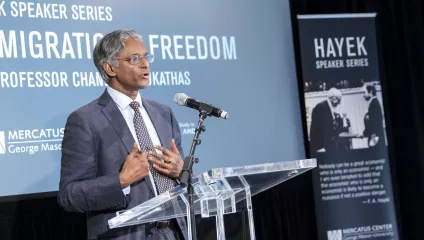- | International Freedom and Trade International Freedom and Trade
- | Expert Commentary Expert Commentary
- |
Trump Is More Serious Than You Think about Building the Border Wall
We should take Trump at his word when he says he plans to build and operate the wall.
Back in May, the House of Representatives passed a $1.6 billion appropriation to fund President Trump's promised Mexican border wall. Now, what seems like several dog years later, final funding for the wall became a political pawn after Trump threatened to veto emergency debt-limit legislation unless it is included. There was also talk that funding the wall could become a spoonful of sugar to bring federal relief to hurricane Harvey victims.
But just how serious is the president about building and operating a Mexico-United States barrier? Is he committed to the project, or, as some have wondered, is talking and jockeying about it enough, by itself, to prove to his base that he hasn't forgotten his promise?
Buried deep in a July analysis of the administration's 2018 regulatory budget by George Washington University's Regulatory Studies Center is powerful evidence that Trump is deadly serious about building the wall. In fact, as pointed out by the Center's Susan E. Dudley and Melinda Warren, "Agencies within the Department of Homeland Security … are the big budgetary winners, including Coast Guard, Immigration and Customs Enforcement, Customs and Border Control, and Transportation Security Administration."
DHS is where the wall operators will be employed. When measured by employment, the president's 2018 budget calls for a grand total of 279,992 people to be employed in all regulatory agencies. These include the Food and Drug Administration, Occupational Safety and Health Administration, Federal Trade Commission, Environmental Protection Agency and 73 other agencies and departments. Some 148,152 people, or 53 percent of the total employed in all regulatory agencies, are designated for the Department of Homeland Security, an agency that came into being in 2002.
The Dudley-Warren study reports that, overall, 2018 regulatory employment is set to fall 0.5 percent, but there are large differences in the fortunes of various agencies. Some are losing resources while others, including DHS, are gaining them. For example, the ranks of the EPA are set to be cut by 24.6 percent, which brings its workforce to the 1984 level. Employment at the National Labor Relations Board is to be cut 17.3 percent, and the Federal Communications Commission's workforce is slated to fall 12.2 percent.
Of course, none of this happens until Congress develops and approves a final budget. But that is not the point. What we have is powerful evidence that Trump fully intends to build and operate a border wall.
It is interesting to say the least that Homeland Security, formed in 2002 response to the Sept. 11 attacks, has become a regulatory giant. Regulatory scholars have traditionally placed agencies into two categories: economic and social. The economic regulators set rates, prices, and grant certificates for entry into markets. Social regulators, such as the EPA, specify how products are produced and marketed. Homeland Security's advent seems to call for another regulatory category, one that focuses on traveler protection and border management, what might be called "commonwealth protection."
In any case, no matter what we call it, we should take Trump at his word when he says he plans to build and operate the wall.
